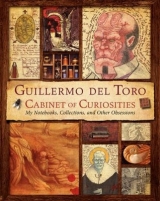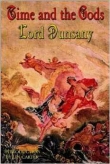
Текст книги "Cabinet of Curiosities: My Notebooks, Collections, and Other Obsessions"
Автор книги: Guillermo del Toro
Соавторы: Marc Scott Zicree
Жанры:
Публицистика
,сообщить о нарушении
Текущая страница: 10 (всего у книги 17 страниц)
HELLBOY

Page from Rasputin’s journal by Mike Mignola.

Storyboard panel of Sammael by Simeon Wilkins.

Drawing of Hellboy by Mike Mignola given to del Toro when wrapping Hellboy preproduction.

Sculpture depicting Hellboy’s confrontation with the Behemoth.

Rasputin (Karel Roden), flanked by Ilsa (Biddy Hodson) and Kroenen (Ladislav Beran).

Storyboard panel of Abe Sapien by Simeon Wilkins.

Concept of a young Hellboy by Wayne Barlowe.

Sammael sculpture by Spectral Motion.
“AT ONE POINT, I was going to do Mimic, and Jim Cameron said, ‘Aren’t you afraid people will pigeonhole you as a horror director?’” Guillermo recalls. “I said, ‘I’d love that!’”
Artist and writer Mike Mignola—the creator of the Hellboy comic book series—is a kindred spirit, someone who happily let his passion for horror tropes define his place in the world of comic books. “I’ve just always liked monsters,” Mignola said in a 2012 podcast interview with Geek’s Guide to the Galaxy. “Since I was a little kid, it was always the thing I found interesting. It’s always what I wanted to draw. It’s always what I wanted to read.”
In the same interview, Mignola recalled how he came up with the comic’s eponymous character. “I’d made some noise about creating my own comic. I’d been working for Marvel and DC for ten years, had done a little bit of everything…. The more I thought about it, the more I really wanted to draw just what I wanted to draw, and the only name I’d ever come up with was Hellboy.”
Mignola added, “For whatever reason, the comic… appealed to a broader audience maybe than a lot of the regular comics I was doing. And then certainly you’ve got to give a lot of credit to the movie. I got really lucky that a very, very talented director happened to be a fan of the comic.”
Harlan Ellison has said that everything a writer writes, whether fiction or nonfiction, is ultimately autobiography, and this is certainly true of Guillermo’s approach to writing and filmmaking. The reason he was drawn to Hellboy was that he saw himself in this ungainly, unlikely superhero, this extraordinary outsider, this child-man striving to find a place for himself in a world ill-suited to his dimensions and diversions. Not for Guillermo were Batman or Superman, those oddballs who nevertheless so successfully imitate normal men. Hellboy, on the other hand, someone who lacks that ability, was a perfect fit.
From the start, Guillermo brought Mignola in to work closely with him on the movie’s design and story elements, but nonetheless Guillermo felt free to deviate from Mignola’s comic book to explore issues that were personally important. “Even though they both arrived on Earth in the forties, somehow del Toro’s Hellboy is still a lovesick teenager,” Mignola explains. “My Hellboy is modeled on my father in some way, a guy who’s been in the Korean War, and he’s traveled and he’s done a lot of stuff, and he’s kind of got a ‘been there, done that’ attitude. He’s been in the world. And del Toro’s change was to have Hellboy bottled up in a room and mooning over the girl he can’t have. My Hellboy, there were just no girl problems. That element of the character was completely not in the comic.”
As with Blade II, Guillermo realized that he wanted to craft a film that would appeal to a particular aspect of himself: the eight-year-old boy inside. That meant that Hellboy would be excessive, he explains, “in the way that a gold-leaf-covered Baroque church in Mexico is excessive. The whole statement is excess. And if you know me, and you know my life, and you know my house, I’m not exactly going for the Zen stuff. So the two Hellboys are very excessive.”
Hellboy’s excessiveness extended in particular to the color palette, with no apologies. Visually, Guillermo notes, “the films I’m the proudest of are the Hellboys, because I don’t care if people like them or not, I just think they are absolutely beautiful to look at.”
Not every bold idea planned for Hellboy made it into the final 2004 film. “Originally, the idea for Hellboy was that the whole movie was going to be told with When Harry Met Sally–type of interviews,” Guillermo explains. “So people would be saying, ‘I saw Hellboy over here. I saw him jump,’ and a kid saying, ‘I saw him on the rooftop.’ Now everybody does it, but back then it was 1997, ’98, and I thought that was a great idea. That was the first thing we cut out of the shooting schedule because [the studio executives] didn’t understand it.”
Even after being narratively domesticated, Hellboy provided fertile ground to plant seeds from earlier unmade projects. In the notebook pages, we see Guillermo drawing heavily on design elements from his unrealized film adaptations of At the Mountains of Madness (from the novel by H. P. Lovecraft), Mephisto’s Bridge (from the novel Spanky by Christopher Fowler), and The Left Hand of Darkness (a version of The Count of Monte Cristo by Alexandre Dumas).
In Hellboy’s villain Kroenen (Ladislav Beran), the steampunk aesthetic of The Left Hand of Darkness was given a Third Reich twist. The studies Guillermo created for Mephisto’s Bridge yielded Kroenen’s face, devoid of eyelids and lips. And from the nightmarish Old Ones of At the Mountains of Madness, Hellboy’s demon Sammael (Brian Steele) was birthed.
Amid simulated blood splotches and arcane symbols reminiscent of Lovecraft’s Necronomicon, Guillermo explored design elements for all Hellboy’s main characters. He was particularly intent on rendering both Hellboy (Ron Perlman) and his sidekick Abe Sapien (Doug Jones) vivid and—for all their peculiarities—human. Most notably, Guillermo strove to evolve Hellboy from the creature Mignola devised into something Ron Perlman could play, drawing him as a hundred-year-old Victorian, an elegant creation in long pants, or cloaking him in a U.S. Civil War–style leather coat. He wrote in the notebook’s margin: “Hellboy has lots of cats running around everywhere.” All these embellishments, Guillermo relates, were “my ways of finding Ron in there.”
Many of the notebook’s concepts made it into the film, while others were abandoned due to budgetary concerns, production logistics, or in the interest of gaining a PG-13 rating. In one case, though, Guillermo jettisoned a fish mouth intended for Abe Sapien because a horrified Mignola offered to give him any four original Hellboy comic panels if he would abandon the notion.
In the end, Hellboy shares the signature trait of all Guillermo’s English-language, studio-sponsored films—Guillermo himself, who throws his entire self into every film wholeheartedly. “Everything about me is consistent,” he observes. “People have a saying in Mexico, ‘The way you eat is the way you dance, the way you dance is the way you fuck,’ and you continue like that.
“I haven’t made eight movies. I’m trying to make a single movie made of all those movies. To me, it’s like Bleak House. I’m building room by room, and you have to take it as a whole in a way. Does that mean that maybe Devil’s Backbone and Pan’s Labyrinth make Mimic a little less terrible? I think so. Or the echoes of those may make Blade II more interesting? I think so.
“The one thing I can say is that, inarguably, I may go three, four years without shooting a movie here or there, but everything I’ve done I’ve done on my own terms. I’ve never had to stray from what I believe is right.”

The notebook containing del Toro’s notes on Hellboy (Notebook 3), opened to pages 15A and 15B, which contain an early iteration of the demon Sammael with wings.

Basil Gogos’s portrait of Hellboy as a Victorian gentleman, commissioned by del Toro.
 MSZ: And here [opposite], of course, we have this elderly Hellboy.
MSZ: And here [opposite], of course, we have this elderly Hellboy.
GDT: What is funny is that he is dressed like a nineteenth-century gentleman, and he is supposed to be a hundred years old. Mike plays with the universe of Hellboy, and I was fascinated by the fact that Hellboy can be in a samurai context, or he can be in a Victorian context, and there’s no explanation given. I just like the idea that his sideburns are like Victorian sideburns. There’s no explanation. I just wanted to do it. I also wanted to find a way to work with the stumps of the horns because Mike does them so quickly they are like goggles on top of his head. I was trying to figure out, “Are they jagged? Are they… ?” This was the first approach, where they are rolled, but that didn’t work. We ended up grabbing a piece of ivory, breaking it, and doing those surfaces.
MSZ: In the notes on the page, you mention Basil Gogos—that you had hoped he would do a painting of this.
GDT: He did. It’s upstairs at Bleak House. It’s a funny story. I had not met Basil or contacted him. It was the early days of the Internet, so I went through the white pages, and I just found, like, four Gogoses in New York. There was a “Gogos, B.,” and I called, and he picked up, and I said, “Are you Basil Gogos?” He said, “Yes.” And I commissioned the painting. At the time it was so expensive for me. I don’t know how I paid him.

NOTEBOOK 3, PAGE 19B
Del Toro’s illustration of Hellboy at at advanced age.
–During the [?] they disconnect the phone, but she has the cell phone so he hears her whole plea. They cut the power off. They lock the windows and the doors, and open a window to blow out a candle.
–The tape is about the adults’ failure and absence
–Someone discovers one of them trapped in one of the mousetraps. It’s bleeding!!
When I made this portrait of Hellboy, I thought it would be used as the basis for an oil painting by Basil Gogos, but it looks as though this isn’t going to happen. Yesterday I thought that Mignola might be able to do the Monte Cristo comic because his style lends itself very well to the Gothic. I think the mechanical hand might be very interesting visually. What would happen if I proposed to do Mephisto with Ted McKeever. I think it might be a good idea.
Señor HB at age of 101 yrs.

Del Toro thought to cloak the character in a duster that would hide the dissimilarity of square human shoulders to the sloping arms of Mike Mignola’s original character. Mike Mignola, Hellboy’s creator, endorsed the idea by drawing Hellboy in the long coat.
 GDT: This drawing [opposite] is a variation on Mignola, because Mignola does the sloping gorilla shoulders [above]. The reason I drew this was I was already thinking of Ron Perlman in the role, which meant the shoulders needed to be human. I wanted to see how he would look. Some of the stuff that ends up in the movie is already there. You can see he’s wearing pants, whereas Mignola’s Hellboy wears shorts. This is already my way of finding Ron in there.
GDT: This drawing [opposite] is a variation on Mignola, because Mignola does the sloping gorilla shoulders [above]. The reason I drew this was I was already thinking of Ron Perlman in the role, which meant the shoulders needed to be human. I wanted to see how he would look. Some of the stuff that ends up in the movie is already there. You can see he’s wearing pants, whereas Mignola’s Hellboy wears shorts. This is already my way of finding Ron in there.
This drawing is also important in the sense that it was right at the time where I felt, “It’s going to happen.” So I drew Hellboy because I felt, “Well, I gotta learn to draw him before I make the movie or I won’t be able to understand him.” So this was an attempt.

The idea was implemented in the costuming for the film.

NOTEBOOK 3, PAGE 30B
to help ensure an actor could play Hellboy.
Another version of Hellboy drawn just to kill time or so I don’t forget.
Agoura Hills on 25/11/2001

NOTEBOOK 3, PAGE 18A
One of the challenges del Toro faced on Hellboy was minimizing the ape-like qualities of his protagonist
–Domu, he’s mugged in the subway and kills every one of them there.
–She and him are able to do the fastest reading of books and files.
–It takes I blackout to go back to the Middle Ages in any city anyplace.
–“Fuck you. I have more taste on my dick.”
DAOD —Dad please get me out of here. I’m so, so tired. Get me out.
–You have a choice: You can believe her or simply think that she’s having a total nervous breakdown. Either way her mother will help her calm down.
H.B. running
–Climbing the rose trellis.
You’re telling me that something reached out through that fireplace and pulled them through the hole?
–I only know what I’ve been able to piece together over the years. He opened the fireplace. But it was already there…
Smoke. Dissipated with wings

By making the character more human, the love story between Hellboy (Ron Perlman) and Liz (Selma Blair) would be believable.
 MSZ: The evolution of how you approached Hellboy is interesting. I remember there’s a note in this notebook where you say initially you were thinking of doing Hellboy as CG, and then maybe having close shots of a real person. But, of course, that evolved and that wasn’t how you approached it.
MSZ: The evolution of how you approached Hellboy is interesting. I remember there’s a note in this notebook where you say initially you were thinking of doing Hellboy as CG, and then maybe having close shots of a real person. But, of course, that evolved and that wasn’t how you approached it.
GDT: Well, that shift came out of a conversation with Jim Cameron. I was saying to him, “I want to create a giant puppet like Mighty Joe Young,” because I love gorillas, and I thought, “Hellboy could be kind of King Kong–ish—a big, ten-foot-tall brute.”
I visited Rick Baker, and I saw the controls of Mighty Joe Young, and I said, “It’s absolutely possible.” I asked Jim, “What do you think?” And Jim said, “That’s a great idea, except there’s one thing you won’t be able to do.” And I said, “What?” “The love story. Because you can make the girl kind of like the monster, but the really human love story, that’s not going to play.” I said, “That’s absolutely right.”
So I went back and talked to Rick. He said, “Well, there are these two guys, Chad [Waters] and Matt [Rose], that are obsessed with Hellboy, and they want to do a test for you where he’s Ron Perlman.” And I always wanted him to be voiced by Ron regardless—I always wanted Ron to be the face of the character. So they did that bust on the stairs at Bleak House [above right], Matt did, and it was clear to me it was going to be a prosthetic job.


An important part of this process was finding star Ron Perlman in Hellboy’s features.

NOTEBOOK 3, PAGE 19A
Figuring out how to make the creature’s limbs changeable.
One-year embryo
Sammael as a fetus
Reversible arms for Sammael.
“Reversible” legs for Sammael
Fingers can turn in any direction
Mouth with outside tongue.

Wayne Barlowe created the first successful concept that addressed this need by incorporating a hidden bone spur into the demon’s forearm,

which Mike Mignola then depicted in his signature style.

One of del Toro’s main concerns was the design of Sammael.
 GDT: The two creatures that have taken the longest to figure out in my films are Sammael and the plant guy on Hellboy II. They took the longest. Sammael went through—I’m not exaggerating—probably thirty or forty iterations, at the very least. Full on, “Let’s go this way… No, no, let’s go that way.”
GDT: The two creatures that have taken the longest to figure out in my films are Sammael and the plant guy on Hellboy II. They took the longest. Sammael went through—I’m not exaggerating—probably thirty or forty iterations, at the very least. Full on, “Let’s go this way… No, no, let’s go that way.”
The elements I wanted were always there: bone, limbs that can change, a really long tongue. And here [opposite] I was just doing some anatomical sketches. The thing on the bottom right is the tongue. I was playing with the idea of limbs that could switchblade out of themselves. It’s not very clear in the rendering, but the bone is in the middle of the forearm, so you can extend the forearm. And I was trying to figure out how he would roll the tongue inside of the thorax. Like, how much space the tongue would occupy, if I could put human fingers at the end of the tongue. Silly stuff, but I was trying to figure it out.
MSZ: It’s great. And then are these little nonsensical annotations mixed in with Spanish?
GDT: Yeah, yeah, I liked them because I’ve always been in love with the idea of the Necronomicon.
MSZ: So, where does this fit into the design phase? Does it start with you doing something like this and then bringing it to your design team?
GDT: Yeah. This was done before I had Wayne Barlowe, or Mignola, or anyone.
MSZ: So this represents the beginning of the process.
GDT: Yes. In general, the more notes in the notebook, the less of a team I had.

NOTEBOOK 3, PAGE 38A
For a while during preproduction, Sammael had horns…
–Kroenen’s room. A dirty mosaic. Filled with pipes and black hoses
MOUTH on his “hand”
Structures made of bars on every street and in all the cavities of the buildings.
HB.
TWO OR THREE NIPPLES ON ONE SIDE
Sammael must be asymmetric like a crab or a malformed foetus. He has 2 eyes on one side and a big ass on the other one. A small claw on one arm
He should be an ornate creature much like H.B markings. Call him “brother”
He has double-jointed legs if Mike Elizalde thinks so.
Bigger claw with a Haialai basket of boney tissue.
ROWS OF NODULES

…which were abandoned in favor of tentacles.

The creature’s double-jointedness, seen in action in these storyboards by Simeon Wilkins, remained a defining characteristic throughout the creature design process.
 GDT: Sammael again [opposite]. Now, the one thing that I am sad we lost on Sammael was the horns, because I really liked that demonic silhouette. But we preserved a lot of stuff. I love that double-jointedness for the pincers, but, again, it was very hard to keep. And, as you can see, he was always asymmetric. But the elements are all there—the circles, the spirals, the bones extruding from the skin, the tentacles, the eyes, the many rows of warts, the protruding pelvis, and the double-jointed legs. Those were things that were important, and you see them repeated again and again in the drawings.
GDT: Sammael again [opposite]. Now, the one thing that I am sad we lost on Sammael was the horns, because I really liked that demonic silhouette. But we preserved a lot of stuff. I love that double-jointedness for the pincers, but, again, it was very hard to keep. And, as you can see, he was always asymmetric. But the elements are all there—the circles, the spirals, the bones extruding from the skin, the tentacles, the eyes, the many rows of warts, the protruding pelvis, and the double-jointed legs. Those were things that were important, and you see them repeated again and again in the drawings.
The problem is, when you see a drawing like this, I find the silhouette interesting, but it doesn’t feel like a creature. It feels like a bunch of notions put together.
MSZ: You said you were sorry to lose the horns. Why was that?
GDT: I liked the horns because they were designed to come out of the floating cheekbone, and then the floating cheekbone would echo the first row of horns, and then the second. I just liked that it had an African mask quality.

NOTEBOOK 3, PAGE 40A
–100,000 dollars you can visualize. A 1,000,000 fits in 2–3 cubic feet. Buys you a house. A really, really big, nice house. Then you start going into abstraction. Well is the same thing with years.
TANOSHI WILLOW TOWN—Boken Shonen Shadar, Ogon Bat, Toriton (OSAMU, T Nekome, Dororo, Marine and the patrol. oceanica, Okami Shonen Ken (pepito) Fushigina Melmo, Skyers-5 (s-5
–The interesting thing about Junji Ito is that he rarely offers explanations in his horror stories. He was a dental assistant and in a certain way his brand of horror shares the same precise attention to biological detail and exerts the same morbid fascination as his old job. Show, don’t tell.
–The Sammaels move in unison like a “chorus line” a la Harryhausen in Jason.
–The world’s greatest paranormal detective. I must say he can’t detect much can he—?
–In Wind in the Willows, the trees move so that people can’t get in, and the animals greet one another with “may man avoid you” or “may man ignore you” whether it’s day or night.
–The Beaver [?] (the human “boat”) in the gigantic [?] and, in order to save himself, he must abandon his “human” body.
–Toad and Beaver become very good friends, and at the end they’re seen flying together in an enormous dirigible that they both built together. Only Ratty is an adult. The others are children.
 GDT: What’s great about this page [above] is the mechanism in Sammael’s arm is almost exactly how it came out. The unfolding blade is there, and on the facing page [opposite] you can see me again trying asymmetric eyes. The wart rolls, the tentacles. And this element of the protruding bone again. But that didn’t make it.
GDT: What’s great about this page [above] is the mechanism in Sammael’s arm is almost exactly how it came out. The unfolding blade is there, and on the facing page [opposite] you can see me again trying asymmetric eyes. The wart rolls, the tentacles. And this element of the protruding bone again. But that didn’t make it.
And there’s a little note to have Hellboy grabbing the mosaic or the tile as he is being dragged backward, which made it into the subway scene [opposite, top]. In a different way, but I did it. I originally wanted it for a fight with Kroenen, but, you know. One does what one can.

NOTEBOOK 3, PAGE 40B
–Mammalian Diving reflex. Body memory.
–The Sammaels move in “Chorus line”–style in the egg chamber
–Hellboy uses his hand to stop himself from sliding, destroying the mosaic floor.
–Random ideas for Sammy
–His shoulder blades have peaks on them that stick out in his silhouette.
Old, hard bone
String of nodules that stand up and push against each other.
Only one eye on this side, but it‘s a big O and blind
Layers that peel back to reveal the horse’s skull beneath them.
Human eyes, but in groups of 3, 5 on one side.
2 of his tentacles should be translucent with blood inside.
The other tentacles form a “mane” around his mouth.
A large number of nodules and infected, asymmetrical nipples on his sunken, dead chest.

NOTEBOOK 3, PAGE 20A
The design of the breathing apparatus Abe Sapien (Doug Jones) wears when he is out of water went through a number of iterations, including an asymmetrical helmet.
–Olivier is a tiger, Javier is a mammoth.
–Episode with a brigade soldier with a rifle in a tree. There he removes the ring he gives to Conchita. In the middle of a sandstorm.
–Look for the ghost’s torso. It could he “splattered” with blue paint “blue screen.” Irregular patterns. CGI
–Just a mistake, that’s all, I thought I was human.
“Abe” with a helmet and his respirator
 GDT: The idea I was exploring here [opposite] was how to make Abe Sapien blink. Because back then it was so expensive to make him blink. I knew I needed to make him blink digitally because there was no way I could hide a mechanism in the face. So I said, well, if his breathing apparatus is very elaborate but cool-looking enough, I can have the bubbles in the water, and the eyes lit, and people will find him entertaining, and I don’t have to spend all that money on making him blink. So I designed that, and I added little fishes in the way that you would draw a cheesecake girl as nose art on a World War II bombardier. Or the way that Joker puts “Born to Kill” on his helmet in Full Metal Jacket.
GDT: The idea I was exploring here [opposite] was how to make Abe Sapien blink. Because back then it was so expensive to make him blink. I knew I needed to make him blink digitally because there was no way I could hide a mechanism in the face. So I said, well, if his breathing apparatus is very elaborate but cool-looking enough, I can have the bubbles in the water, and the eyes lit, and people will find him entertaining, and I don’t have to spend all that money on making him blink. So I designed that, and I added little fishes in the way that you would draw a cheesecake girl as nose art on a World War II bombardier. Or the way that Joker puts “Born to Kill” on his helmet in Full Metal Jacket.
MSZ: So these aren’t real fish. They’re intended to be a motif?
GDT: Yeah. Like, he was drawing on his helmet. And the respirator on the side was sort of like a bellows. Those ended up being Johann’s in Hellboy II.
MZ: Why did you move away from this design? Because it’s a very fun design.
GDT: Well, I got away from it because, when we finally went to make the movie, José [Fernandez] at Spectral Motion took a long time to get to Abe. We fucked around for a long time. Then Wayne Barlowe did a beautiful drawing, and Mignola refined it, and then José sculpted it, and it was so gorgeous that I said, “I’m not going to fucking hide the face.” So I just gave him goggles, goggles with water. Because the face, it was so harmonious. The worst thing you can do—and this is really useful advice—in any design, the worst thing you can do is make a big-headed design. The head has to be the smallest part of the creature.
MSZ: Why is that?
GDT: It’s just aesthetically more pleasing. It’s also the worst thing you can do with statuary. I mean, a lot of statuary is done like that because you are meant to look at it from below, so a lot of the sculptures have big heads and big shoulders because you’re looking at them on a pedestal. But the sign of a really bad sculptor is that they do big-headed designs. And a bad draftsman, a lot of the time, has a tendency for big-headed designs.

Underwater scenes, such as the one where Abe dives into the cistern to retrieve the reliquary, reveal his true, more expressive face. Storyboards by Simeon Wilkins.

A more elegant combination of goggles and neck-wrap.


Throughout the notebooks, del Toro persistently draws variations of an asymmetrical helmet, which he has tried to incorporate into several films.
 GDT: At the top [opposite] here, on the left, I very much wanted Hellboy to be talking to someone who was trying to soothe him. You know, “Don’t do that.” But then Hellboy just punches him through the door. But I didn’t do that until Hellboy II, when he punches Johann in the locker room. I like him losing his temper abruptly.
GDT: At the top [opposite] here, on the left, I very much wanted Hellboy to be talking to someone who was trying to soothe him. You know, “Don’t do that.” But then Hellboy just punches him through the door. But I didn’t do that until Hellboy II, when he punches Johann in the locker room. I like him losing his temper abruptly.
Then I’m gonna keep doing this drawing until I get a helmet with two lenses on one side and one in the other. First on Abe Sapien, then on Blade, and then here.
MSZ: What was this particular version intended for?
GDT: Well, I love Russian technology, and I thought of the idea of a leather cap for when they go to Rasputin’s tomb in Moscow in the winter. I wanted to create a leather helmet like an aviator cap with a set of goggles for Hellboy. The idea was that he would use it to detect the talking corpse. Of course, that didn’t happen.

NOTEBOOK 3, PAGE 38B
This particular iteration was supposed to allow Hellboy to locate the talking corpse in Hellboy. Although the idea was abandoned for that film, del Toro was able to create something similar with the Schufftein glasses in Hellboy II.
–Hellboy fucks Kroenen up through a wall or door.
– Final battle “a la” CB? If anime can he translated into an image
– HB wears leather protection with asymmetrical goggles of eastern European design for his trip to Moscow
The texture of HB’s horns should be plainly visible so that they don’t look like goggles
–His face is covered with a series of steel belts.
–The jacket needs to have a collar that can be turned up
–In 1945, when I was 10 years of age I decided to write a book. It would detail my father’s biography. A small story about a small family. The very moment I started writing it, I would feel so full of nostalgia and a sense of loss that I would stop and hurry to his side. Crying. This is as far as I ever got: I live with Dad. We are very happy.

NOTEBOOK 3, PAGE 39A
–Amber-colored Chinese neon signs. If we make the noodle factory, the water needs to look disgusting.
–HB’s bullets are made in Japan and are activated when they are pulled out of their package.
–HB’s leather jacket should be made of leather but it should be lightweight enough to blow in the wind
–A “tracking bullet” is shot at sammael from behind an oilskin window. It vanishes in a “grotto” leading to the subway. Puddles slow.
–We’ve already seen the man who works in the subway in another sequence
–An exhaust fan blocks the light with steam. The plastic curtains are lit from behind.
–Kroenen puts together watches as a hobby. Loose parts
–A girl with Down’s syndrome sees HB and draws a picture of him in a little notebook.
–Telephone call. Static. For the girl with Down’s. Laughter.
–A ghost is what survives death. As an amputation. A scar on the soul. The remains of a destroyed soul.
–Ramps and elevators with [image of lines] and with enormous concrete numbers on them
–They travel in garbage truck. A and HB
 GDT: Well, the page above is mostly notes, with this image of a shower curtain with a symbol. I like the idea of things behind plastic. You can see it in Mimic, you can see it in Cronos. On Hellboy, I really liked the idea of finding a series of plastic curtains and seeing Kroenen moving behind them. The idea being that the symbol was painted in blood.
GDT: Well, the page above is mostly notes, with this image of a shower curtain with a symbol. I like the idea of things behind plastic. You can see it in Mimic, you can see it in Cronos. On Hellboy, I really liked the idea of finding a series of plastic curtains and seeing Kroenen moving behind them. The idea being that the symbol was painted in blood.
This ended up in the morgue when Kroenen resurrects. The DDT guys were covering the Kroenen puppet with a very light plastic sheet because they didn’t want crap to deposit on the silicone. When I saw that, I said, “Give it to me for real.” What I did is, he wakes up with the sheet attached to him, and as he takes a few steps, he steps on the plastic sheet, it pulls down, and it reveals his face. Then we go behind the screen, and instead of him, you just see the screen, and his silhouette in plastic, and then he comes out. So that made it into the movie somehow.
On the facing page is Abe Sapien and his two lenses on one side, and one lens on the other. One day, one day, it’ll happen. I have faith. The respirator is not exactly like it is in the movie, but it’s pretty close.
And you can see the lock in the safety deposit door that is the entrance to the BPRD.
On the bottom [opposite]: I originally had the idea for a mechanical collar on Kroenen that injected through clockwork—injected a substance into his brain to keep the corpse alive. But then I came up with this notion of a ridiculous wind-up. I said, “It makes as much sense as a syringe.” I liked the idea of a really elaborate wind-up that is massaging his organs as he moves. It’s an oblique reference to a guy in a James Bond movie that I saw when I was a kid—the clock that massages a little mechanism that awakens him from the dead.
MSZ: Then you have him saying, “It’s so easy!”
GDT: Just a ridiculous statement. Like, “It’s so easy to stay alive after you’re a corpse. Boys and girls, order your injection today!”

DDT created a number of concepts for the syringe that would hold the mysterious, life-giving substance before the idea was abandoned in favor of the wind-up mechanism seen in the final film.

NOTEBOOK 3, PAGE 39B
Originally, Kroenen was to be kept alive through regular injections administered by a clockwork mechanism.
–The “bad guys” emerge from mirrors or shadows.
–Post-cognitive. He knows what already happened
–Stainless steel pistons move in unison.
Abe with his water goggles and external respirator
–Railroad signals on the train or subway tracks.
–Shot of Kroenen’s syringe. Camera turns 360° and then cuts!!

NOTEBOOK 3, PAGE 37A
–Huge [images of bullet cartridges] from the Samaritan
–There are idyllic photographs of Nazi youths in Kroenen’s room.
–Kroenen’s hand with flesh interface.
INTO THE FLESH
The hand is heavily adorned.
– Skull-faced mask. Room with asbestos modules.
–1920 industrial Gothic.

Ron Perlman posing as Hellboy with Big Baby in a publicity photo for Hellboy II.
 GDT: Well, first of all, as you can read on the top left [opposite], one of the things that I wanted to do with the Samaritan was to create huge ammo for the revolver. Huge bullets. But originally I wanted it to be an automatic weapon that would eject the shells. And we couldn’t do it. I couldn’t find a way to design it properly. But we kept the idea of the shells being huge.
GDT: Well, first of all, as you can read on the top left [opposite], one of the things that I wanted to do with the Samaritan was to create huge ammo for the revolver. Huge bullets. But originally I wanted it to be an automatic weapon that would eject the shells. And we couldn’t do it. I couldn’t find a way to design it properly. But we kept the idea of the shells being huge.
Ron is a big guy. He has a huge head and huge hands, so the gun looks normal, almost, in his hands. So I had to create the Big Baby in the second movie for it to look like a big gun, and the bullets of the Big Baby are the size of a baby’s bottle, and they have a baby bottle inside.
Then there is a Kroenen hand on this page, which is literally, if you go back to the earlier drawings of The Left Hand of Darkness, the Monte Cristo hand [see page 258]. And, again, it’s a matter of “I want that image. I don’t care where it comes from.” [laughs]








